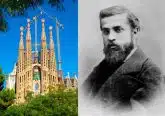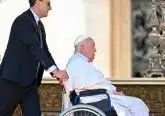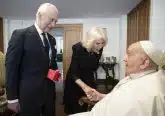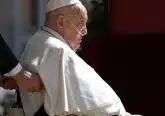Traditional Latin Mass restrictions: Here’s what you need to know
Denver Newsroom, Dec 18, 2021 / 07:53 am
New moves by Pope Francis mean changes for Catholics dedicated to the Traditional Latin Mass —and for the priests and bishops responsible for these communities.
Even though these Catholics represent a relative small minority of believers, the changes have ramifications for the entire Church. Here’s what you need to know about the rules the pope set forth in a document called Traditionis custodes.
What is Traditionis custodes?
Traditionis custodes is a July 16 instruction called a motu proprio. In this document, Pope Francis made major changes to the place of Traditional Latin Mass in the life of the Church.
His predecessor Benedict XVI had issued a 2007 apostolic letter, Summorum Pontificum, which acknowledged the right of all priests to say Mass using the Roman Missal of 1962.
What is the Traditional Latin Mass?
Take a look at our First Timers’ Guide to the Traditional Latin Mass.
The Mass said using the 1962 Roman Missal is known variously as the extraordinary form of the Roman Rite, the Tridentine Mass, the usus antiquior, and the Traditional Latin Mass. It was the form of the Mass used for centuries. This form of the Mass has ancient roots, being substantially the same as that found in sacramentaries of the eighth century, but it was especially codified following the Council of Trent in the 16th century.
After the Second Vatican Council of the 1960s, St. Paul VI released a form of the Mass that could be used in vernacular languages.
In the Traditional Latin Mass, the priest faces the altar. Some prayers are different, some prayers are expanded, and some prayers and responses are limited to the priest or those serving at the altar. Traditional Latin Mass communities follow a different liturgical calendar, too.
Why did Pope Francis say Traditionis custodes was necessary?
Pope Francis said he acted “in defense of the unity of the Body of Christ,” on the grounds that there was “distorted use” of the ability for priests to say Mass according to the 1962 missal. The opportunities provided by St. John Paul II and Benedict XVI were “exploited to widen the gaps, reinforce the divergences, and encourage disagreements that injure the Church, block her path, and expose her to the peril of division.”
The pope said he was saddened that the celebration of the extraordinary form was now characterized by a rejection of the Second Vatican Council and its liturgical reforms. To doubt the Council, he said, is “to doubt the Holy Spirit himself who guides the Church.”
He criticized what he said was a growing attitude of “rejection of the Church and her institutions in the name of what is called the ‘true Church’.”
In March 2020, the Congregation for the Doctrine of the Faith’s prefect Cardinal Luis Ladaria wrote to the presidents of bishops’ conferences, asking them to distribute a questionnaire about how Benedict XVI’s Latin Mass rules affected bishops’ dioceses.
Pope Francis said the responses to the survey “reveal a situation that preoccupies and saddens me, and persuades me of the need to intervene.”
What changes are we talking about?
Pope Francis said that the liturgical books issued by St. Paul VI and St. John Paul II are “the unique expression” of the Roman rite. While priests used to have broad rights to decide to celebrate the Traditional Latin Mass, the pope has now established a bishop’s “exclusive competence” to authorize the use of the 1962 Roman Missal in his diocese.
Bishops must determine that existing Traditional Latin Mass groups in their diocese do not deny the validity of the Second Vatican Council and the teachings of the Catholic Church. Also, bishops must designate non-parish churches where these groups may gather to celebrate Mass and establish the days on which they may celebrate. These Masses are to use scriptural readings “in the vernacular language” in translations approved by the relevant episcopal conferences.
Bishops also need to name a diocesan delegate to oversee pastoral care for Traditional Latin Mass groups, and should verify that these communities are effective for spiritual growth.
Newly ordained priests who want to offer the extraordinary form of the Mass now need to make a formal request to their bishop. The bishop must then consult with the Vatican before granting permission. Priests who already offered the Mass in the extraordinary form needed to request authorization from their bishop.
How many people attend the Traditional Latin Mass?
There are perhaps as few as 150,000 U.S. Catholics who regularly attend the Traditional Latin Mass, at about 700 venues. They make up less than 1% of some 21 million regularly Mass-going Catholics.
At the same time, you might find Traditional Latin Mass Catholics in plenty of places. Political and cultural commentators show particular sympathy for this form of the liturgy, and aren’t shy about saying so.
On social media, traditional Catholics can be quite vocal — and even eccentric and abusive. Some devotees of the traditional Latin Mass adhere to the Society of St. Pius X or have unusual beliefs about the papacy and the Second Vatican Council.
In France, there are perhaps 60,000 traditionalist Catholics. They make up perhaps 4% to 7% of practicing Catholics in the country, and a sizable number are with breakaway groups. These communities show slow but steady growth each year and their members tend to be much younger than average churchgoers.
What was the reaction to Pope Francis’ decision?
Many Catholics who attend the Traditional Latin Mass worried that the pope doesn’t understand them.
Pope Francis’ restrictions on the Traditional Latin Mass appeared to be unpopular among American Catholics who regularly attend Mass, but most Catholics in America have not even heard of the changes, the Pew Research Center said in early October.
Critics of the Traditional Latin Mass hope that the Pope’s actions will rein in some Catholic traditionalists who they say have gone too far in their attitude towards the papacy or the Second Vatican Council.
The prefect of the Congregation for Divine Worship, Archbishop Arthur Roche, told a Swiss television station that Pope Francis issued Traditionis custodes because the effort to reconcile the breakaway traditionalist Society of St. Pius X “has not entirely been successful” and because it is necessary to “go back” to what the Second Vatican Council required of the Church.
A Dutch bishop worried that the pope’s intervention was “dictatorial,” “unpastoral,” and “unmerciful,” and argued that it would benefit the Society of St. Pius X.
San Francisco’s Archbishop Salvatore Cordileone spoke out against people he said responded to the pope’s changes in a disrespectful way.
The pope’s action appears to have re-opened long-time debates about the Catholic liturgy that some observers thought had settled into a period of quiet co-existence, despite some polemics on the internet.
Those who still admire Pope Benedict’s broad permission for the Traditional Latin Mass like to cite the previous pope’s own words — and the words of previous Vatican leaders in liturgy.
Before Pope Francis announced his changes, Cardinal Robert Sarah, former head of the Congregation for Divine Worship, took to Twitter July 8 to defend Benedict XVI’s rules on the Traditional Latin Mass: “despite difficulties and resistance, the Church embarked on a path of liturgical and spiritual reform, which, though slow, is irreversible.”
“Despite intransigent clerical attitudes in opposition to the venerable Latin-Gregorian liturgy, attitudes typical of the clericalism that Pope Francis has repeatedly denounced, a new generation of young people has emerged in the heart of the Church,” Sarah said. “This generation is one of young families, who demonstrate that this liturgy has a future because it has a past, a history of holiness and beauty that cannot be erased or abolished overnight.”
Has there been any further directives issued by the Vatican?
Yes. The Congregation for Divine Worship and the Discipline of the Sacraments, the Vatican office responsible for matters related to the sacred liturgy, said it had received “several requests for clarification” on the correct application of Traditionis custodes. For this reason, the congregation on Dec. 18, 2021 published an explanatory document, called a “responsa ad dubia” (“answers to doubts”), with one-word replies — either “negative” or “afffirmative” — to 11 specific questions, followed by brief explanations.
Among other directives, the document bans confirmations and ordinations according to pre-Vatican II Roman Missals.
The intent of the new restrictions is “to re-establish in the whole Church of the Roman Rite a single and identical prayer expressing its unity,” the liturgy office said.
“In implementing these provisions, care should be taken to accompany all those rooted in the previous form of celebration towards a full understanding of the value of the celebration in the ritual form given to us by the reform of the Second Vatican Council,” the document said.
“This should take place through an appropriate formation that makes it possible to discover how the reformed liturgy is the witness to an unchanged faith, the expression of a renewed ecclesiology, and the primary source of spirituality for Christian life.”













